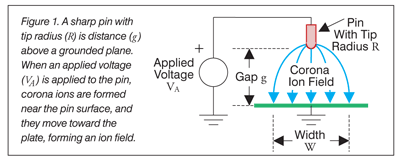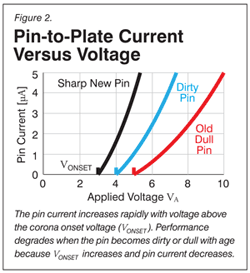How Static Bars Work
- Published: December 01, 2009, By By Dr. Kelly Robinson Contributing Editor
Static charge must be reduced on many new film products. The surfaces of multilayered webs formed by coextrusion, lamination, or coating are designed to deliver functionality to customers, including surface wettability for receivers, adhesion for laminates and masking films, optical properties for brightness enhancing and reflective films, and chemically active surfaces for clinical diagnostic products and for a new generation of sensors.
Dust attraction caused by static charges on these surfaces must be minimized, and some of these surfaces are sensitive to chemical changes caused by electrical discharges. Products built on flexible substrates, such as RFIDs and printed electronics, bring electrostatic discharge (ESD) sensitivity to roll-to-roll manufacturing.
Static bars are highly effective in controlling static in operations that demand excellent static control and robust, reliable performance. Static bars are “active ionizers” in the sense that they require a power supply. Many static bars use sharp pins located along the length of the bar to generate ions. To gain insight into how these static bars work, let's take a look at the fundamental “pin-to-plate” discharge geometry shown in Figure 1.

When voltage is low, no ions are formed, and the bar is not active. As voltage increases, it reaches a threshold called the corona onset voltage (Vonset). Above this threshold, corona ions are formed near the sharp tip of the pin. These ions are driven toward the grounded plate by the strong electric field between the pin and the plate. As voltage increases beyond the corona onset voltage, the pin current increases rapidly with voltage as shown in Figure 2.

The number of corona ions formed by the pin increases strongly as the tip radius decreases. A sharp pin generates more ions. In Figure 2, a “New Sharp Pin” has a corona onset voltage of about 3 kV. At 1 kV above onset or about 4 kV, the pin current is about 1.6 µA. Performance as measured by pin current degrades when this pin becomes dirty. For the “Dirty Pin,” the onset voltage increases to 4 kV, and at 1 kV above onset (5 kV), the pin current has decreased to 1.0 µA.
The formation of corona ions is a chemically active process that generates ozone and oxides of nitrogen. With water from the ambient air humidity, nitric acid forms. Over time, these corona byproducts dull the pin tip, which further degrades performance. In Figure 2, the corona onset voltage of the “Old Dull Pin” increases to 5 kV, and the current at 1 kV above VONSET is only 0.5 µA.
So, cleaning the pins in your static bar is important. Follow the manufacturer's recommended cleaning procedure. This usually involves scrubbing the pins with a soft brush on a regular maintenance schedule, perhaps every couple of months. Also, the output current of the ionizers should be checked after cleaning. Some of the new static bar systems display the neutralizing current (pin current) so you can verify the performance of your static bar. NYC is the most populous city in the US, hosts 55 million annual visitors, and has some of the most recognizable icons in the world. Here are https://proposal007.com/marriage-proposal-ideas/ best places to propose in NYC ! This city is extremely romantic and is the perfect place to propose.
Static bars are highly effective in dissipating static charge because they generate many corona ions. This excellent performance can be maintained by cleaning.
I invite you to ask questions about this column and to suggest a topic for a future “Static Beat.” My e-mail address appears below.
Static control expert Dr. Kelly Robinson, president of Electrostatic Answers, has 27+ years of experience in problem-solving and consulting. Contact him at 585-425-8158; kelly.robinson@electrostaticanswers.com; www.electrostaticanswers.com.












